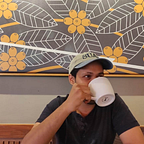Rovie — A continuous-track autonomous UGV
Introduction
In this multi-part article series we discuss the design goals and my thought process behind designing a continuous-track Unmanned Ground Vehicle (UGV).
While working with UAVs extensively for the past couple years, I often wanted to explore UGVs and ground robots. Rovie is my first attempt at designing and building a UGV. It is completely designed in Fusion 360, which I learnt as a hobby during the COVID-19 crisis. As someone with an education in computer engineering, I had to teach myself to design and model using CAD tools and FDM printers.
Rovie is intended to be completely open-source and can be built from scratch using a couple of aluminium extrusions and a desktop FDM printer. With a variable wheelbase and support for various kinds of motors, I’ve tried my best to make Rovie as customisable as possible.
The Chassis
As Rovie was intended to be an all terrain rover, I considered both wheel and continuous-track options. The rover is capable of using either, a continuous track with two-wheel-drive or wheels with independent-all-wheel drive. Finally I decided to settle for the latter as it provides higher power efficiency and traction.
The chassis is constructed with four aluminium extrusions and a couple of printed attachments. Each side uses tracks printed in PLA and assembled using PLA filament to make hinges. Alternatively, steel wires can be used to assemble tracks, which, in theory can be stronger and more durable.
Propulsion
A 23 Watt planetary-gear brushed DC motor provides a maximum of 45 N-cm of torque to the 110mm track pulley on either side. The motor used in my implementation has a built-in reduction gear and a magnetic encoder mounted to the rear shaft.
The power system was designed around a 3-Cell Lithium Polymer battery in mind. The 110 Wh battery uses a battery management system (BMS) which regulates the power and protects the battery. Alternatively, a Lithium Ion battery would provide more capacity in the same package and therefore can be used to increase battery life.
A power distribution board (PDB) sits at the centre of the power system, distributing and managing power to various sub-systems. The PDB also acts as a voltage regulator and steps down 12 volt from the battery to 5 volt and 3.3 volt for different modules.
Dual motor drivers drive the two brushed motors, each handling a peak current of 30A and are controllable with a PWM signal.
The rear pulleys are the driven pulleys while the front ones are the driving, coupled to the motor. The rover’s track (wheel track) is also variable and can be extended by increasing the axle length to incorporate larger motors or batteries.
Track and Pulleys
The driven pulleys use 628ZZ bearings, one on each side of the pulley, four in total. An 8mm smooth rod is used as the axle with shaft collars to keep the pulley mounts in place. The shaft collars themselves are printable and can be fastened with M3x10 bolts. Alternatively a PVC tube can be installed between the two pulley mounts to lock them in place.
After experimenting with various pulley designs I decided to settle for one seen on the right in the image above. Previous designs like the V1 had a triple-locking track but were heavier or inefficient. The V2 design is about 25% lighter and smaller while providing a 4.5 times improvement in locking performance. The V2 track adds small lips (raised edge) that increase contact surface area which in turn bolsters the locking efficiency in the lateral axis.
Both the driver and the driven pulley mounts are printed as a single-piece with minimal supports. They are designed for a screw-less assembly and can be slid into the aluminium extrusions. Adding a small amount of epoxy after final assembly can add strength to the mounts.
The brushed DC motor simply attaches to the driver pulley as seen in the figure.
Conclusion
Since Rovie is intended to be open-source, a wide range of motors can be used depending upon the application requirements. Cameras, LiDARs and other sensors can be mounted for vision and perception.
This is the first of many articles on Rovie, I intend to provide details of each sub-system in the upcoming posts. All designs and links to purchase electronics will be made available soon.
Follow the project here!
